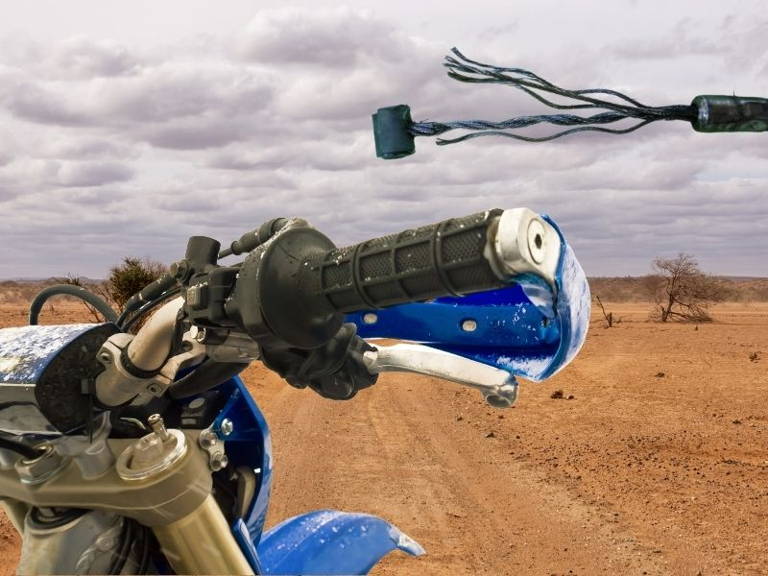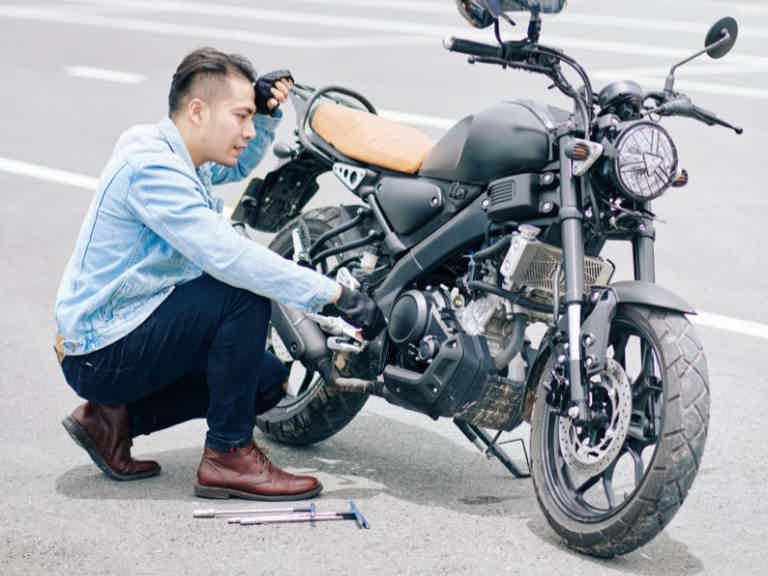Motorcycle Throttle
Sticking?
Best Practices to Prevent
Motorcycle Throttle Sticking?
Warning signs of a sticky throttle
As an experienced rider, it is important to be aware of the warning signs of a stuck throttle. A stuck throttle can be a dangerous situation, causing loss of control and potentially leading to an accident. Here are a few warning signs to be aware of:
1. Difficulty Accelerating: If you notice that your motorcycle is struggling to accelerate, it could be a sign that the throttle is stuck. This is because the throttle controls the amount of air and fuel that enters the engine, and if it is stuck, it can cause a lack of power.
2. High RPM: Another warning sign is that your engine is running at a high RPM even when you are not applying the throttle. This is because the throttle is stuck open, and the engine is getting more air and fuel than it needs.
3. Difficulty Slowing Down:If you are having difficulty slowing down, it could be a sign that the throttle is stuck open. This could be because the engine is still receiving a high amount of air and fuel, even when you are trying to slow down.
4. Engine Running Hot: If you notice that your engine is running hotter than usual, it could be a sign that the throttle is stuck open. This is because the engine is receiving more air and fuel than it needs, causing it to work harder and generate more heat.
5. Motorcycle throttle not snapping back- When you let go of the throttle it should snap back to the idling position. If it does not that is a sign that there is an issue to be investigated.
Whether riding a dirt bike or on the street, if you notice any of these warning signs, it is important to pull over as soon as it is safe to do so and check your throttle. If your engine is revving even when you release the throttle, you can pull in the clutch and hit the kill switch.
Causes of a motorcycle cable sticking
A throttle that sticks can be a dangerous situation for any rider. It can lead to unintended acceleration, which can cause accidents and injuries. There are several causes of a motorcycle throttle sticking, and it's important to understand these causes to prevent accidents and maintain the safety of the rider.
One of the most common causes of a throttle sticking is a dirty or gummed-up throttle cable. Over time, dirt and grime can build up inside the cable, causing it to become stiff and difficult to move. This can lead to a situation where the throttle fails to return to its original position after acceleration, resulting in the motorcycle continuing to accelerate without any input from the rider.
Another possible cause of a sticky throttle is a worn or damaged throttle tube. Over time, the plastic or rubber material of the throttle tube can wear down or become damaged, leading to a situation where the tube fails to move smoothly along the handlebar end. A bar end that was tightened too much can also rub against the end of the throttle tube preventing it from moving freely. This can cause the throttle to stick in an open position or fail to return to its original position after acceleration.
A third possible cause of a sticking throttle is a malfunctioning throttle cable. The cable can become frayed or damaged from lack of proper lubrication, causing it to bind up and prevent the throttle from moving smoothly. If the cable is damaged, it will need to be replaced.
Finally, a sticking throttle can also be caused by a malfunctioning throttle return spring. This spring is designed to pull the throttle back to its original position after acceleration. If the spring is damaged or worn out, it may fail to do its job, causing the throttle to stick in an open position.


Causes of a sticking throttle
A throttle that sticks can be a dangerous situation for any rider. It can lead to unintended acceleration, which can cause accidents and injuries. There are several causes of a motorcycle throttle sticking, and it's important to understand these causes to prevent accidents and maintain the safety of the rider.
One of the most common causes of a throttle sticking is a dirty or gummed-up throttle cable. Over time, dirt and grime can build up inside the cable, causing it to become stiff and difficult to move. This can lead to a situation where the throttle fails to return to its original position after acceleration, resulting in the motorcycle continuing to accelerate without any input from the rider.
Another possible cause of a sticking throttle is a worn or damaged throttle tube. Over time, the plastic or rubber material of the throttle tube can wear down or become damaged, leading to a situation where the tube fails to move smoothly along the handlebar end. A bar end that was tightened too much can also rub against the end of the throttle tube preventing it from moving freely. This can cause the throttle to stick in an open position or fail to return to its original position after acceleration.
A third possible cause of a sticking throttle is a malfunctioning throttle cable. The cable can become frayed or damaged from lack of proper lubrication, causing it to bind up and prevent the throttle from moving smoothly. If the cable is damaged, it will need to be replaced.
Finally, a sticking throttle can also be caused by a malfunctioning throttle return spring. This spring is designed to pull the throttle back to its original position after acceleration. If the spring is damaged or worn out, it may fail to do its job, causing the throttle to stick in an open position.

Maintenance tips for avoiding a stuck throttle
There are several maintenance tips that can help you avoid a stuck motorcycle throttle. Here are some of them:
1. Keep your throttle clean and well-lubricated. Dirt, debris, and rust can accumulate in the throttle mechanism and cause it to stick. Regularly clean and lubricate your throttle to keep it in good condition.
2. Check your throttle cables regularly. The cables can stretch or fray over time, which can cause them to stick. Make sure your cables are in good condition and adjust or replace them as needed.
3. Adjust your throttle play. If your throttle play is too loose or too tight, it can cause the throttle to stick. Adjust your throttle play according to your motorcycle's specifications.
4. Check your throttle housing for damage. Cracks or other damage to the throttle housing can cause the throttle to stick. Make sure your housing is in good condition and replace it if needed.
5. Avoid using the throttle as a brake. This can cause the throttle to stick and is a common cause of accidents. Always use your brakes to slow down, not your throttle.
By following these maintenance tips, you can help ensure that your motorcycle's throttle stays in good working condition and avoid the dangerous situation of a stuck throttle. Remember to always ride safely and practice good motorcycle maintenance.

Maintenance tips for avoiding a stuck throttle
There are several maintenance tips that can help you avoid a stuck motorcycle throttle. Here are some of them:
1. Keep your throttle clean and well-lubricated. Dirt, debris, and rust can accumulate in the throttle mechanism and cause it to stick. Regularly clean and lubricate your throttle to keep it in good condition.
2. Check your throttle cables regularly. The cables can stretch or fray over time, which can cause them to stick. Make sure your cables are in good condition and adjust or replace them as needed.
3. Adjust your throttle play. If your throttle play is too loose or too tight, it can cause the throttle to stick. Adjust your throttle play according to your motorcycle's specifications.
4. Check your throttle housing for damage. Cracks or other damage to the throttle housing can cause the throttle to stick. Make sure your housing is in good condition and replace it if needed.
5. Avoid using the throttle as a brake. This can cause the throttle to stick and is a common cause of accidents. Always use your brakes to slow down, not your throttle.
By following these maintenance tips, you can help ensure that your motorcycle's throttle stays in good working condition and avoid the dangerous situation of a stuck throttle. Remember to always ride safely and practice good motorcycle maintenance.
Warning signs of a sticky throttle
As an experienced rider, it is important to be aware of the warning signs of a stuck throttle. A stuck throttle can be a dangerous situation, causing loss of control and potentially leading to an accident. Here are a few warning signs to be aware of:
1. Difficulty Accelerating
2. High RPM
3. Difficulty Slowing Down
4. Engine Running Hot
5. Motorcycle throttle not snapping back
Whether riding a dirt bike or on the street, if you notice any of these warning signs, it is important to pull over as soon as it is safe to do so and check your throttle. If your engine is revving even when you release the throttle, you can pull in the clutch and hit the kill switch.
Causes of a motorcycle cable sticking
A throttle that sticks can be a dangerous situation for any rider. It can lead to unintended acceleration, which can cause accidents and injuries. There are several causes of a motorcycle throttle sticking, and it's important to understand these causes to prevent accidents and maintain the safety of the rider.
One of the most common causes of a throttle sticking is a dirty or gummed-up throttle cable. Over time, dirt and grime can build up inside the cable, causing it to become stiff and difficult to move. This can lead to a situation where the throttle fails to return to its original position after acceleration, resulting in the motorcycle continuing to accelerate without any input from the rider.
Another possible cause of a sticky throttle is a worn or damaged throttle tube. Over time, the plastic or rubber material of the throttle tube can wear down or become damaged, leading to a situation where the tube fails to move smoothly along the handlebar end. A bar end that was tightened too much can also rub against the end of the throttle tube preventing it from moving freely. This can cause the throttle to stick in an open position or fail to return to its original position after acceleration.
A third possible cause of a sticking throttle is a malfunctioning throttle cable. The cable can become frayed or damaged from lack of proper lubrication, causing it to bind up and prevent the throttle from moving smoothly. If the cable is damaged, it will need to be replaced.
Finally, a sticking throttle can also be caused by a malfunctioning throttle return spring. This spring is designed to pull the throttle back to its original position after acceleration. If the spring is damaged or worn out, it may fail to do its job, causing the throttle to stick in an open position.



Causes of a sticking throttle
A throttle that sticks can be a dangerous situation for any rider. It can lead to unintended acceleration, which can cause accidents and injuries. There are several causes of a motorcycle throttle sticking, and it's important to understand these causes to prevent accidents and maintain the safety of the rider.
1) Dirty or gummed-up throttle cable
2) Worn or damaged throttle tube
3) Malfunctioning throttle cable
4) Malfunctioning throttle return spring

Maintenance tips for avoiding a stuck throttle
There are several maintenance tips that can help you avoid a stuck motorcycle throttle. Here are some of them:
1. Keep your throttle clean and well-lubricated. Dirt, debris, and rust can accumulate in the throttle mechanism and cause it to stick. Regularly clean and lubricate your throttle to keep it in good condition.
2. Check your throttle cables regularly. The cables can stretch or fray over time, which can cause them to stick. Make sure your cables are in good condition and adjust or replace them as needed.
3. Adjust your throttle play. If your throttle play is too loose or too tight, it can cause the throttle to stick. Adjust your throttle play according to your motorcycle's specifications.
4. Check your throttle housing for damage. Cracks or other damage to the throttle housing can cause the throttle to stick. Make sure your housing is in good condition and replace it if needed.
5. Avoid using the throttle as a brake. This can cause the throttle to stick and is a common cause of accidents. Always use your brakes to slow down, not your throttle.
By following these maintenance tips, you can help ensure that your motorcycle's throttle stays in good working condition and avoid the dangerous situation of a stuck throttle. Remember to always ride safely and practice good motorcycle maintenance.


Maintenance tips for avoiding a stuck throttle
There are several maintenance tips that can help you avoid a stuck motorcycle throttle. Here are some of them:
1. Keep your throttle clean and well-lubricated
2. Check your throttle cables regularly
3. Adjust your throttle play
4. Check your throttle housing for damage
5. Avoid using the throttle as a brake
By following these maintenance tips, you can help ensure that your motorcycle's throttle stays in good working condition and avoid the dangerous situation of a stuck throttle. Remember to always ride safely and practice good motorcycle maintenance.



